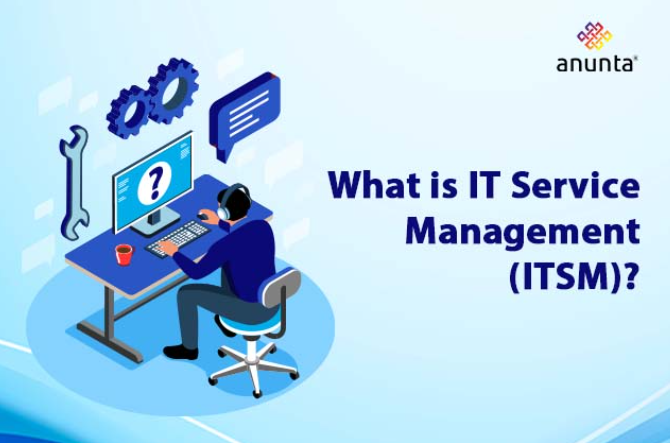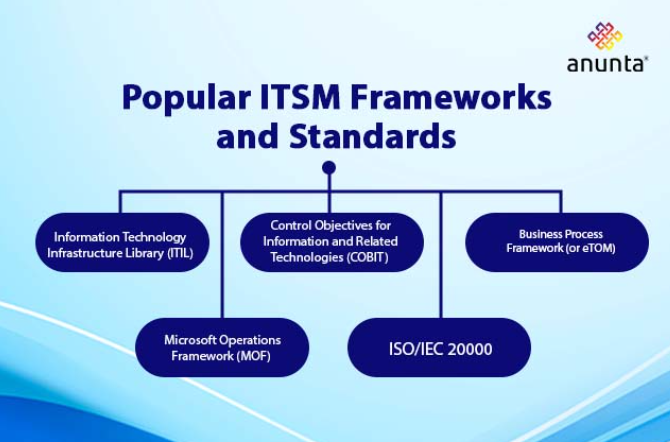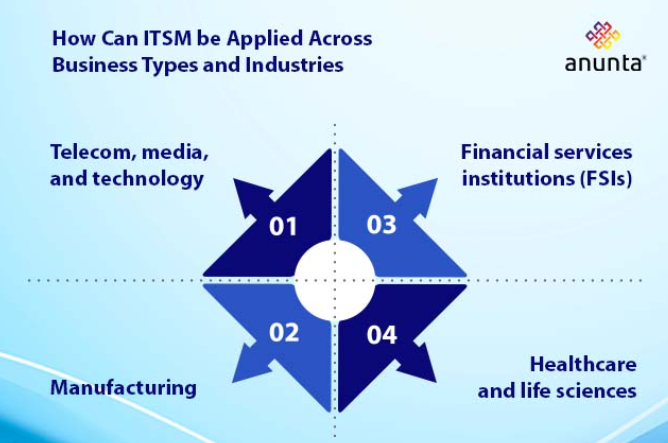
The efficient management of IT services is essential for business success. But what exactly is IT Service Management (ITSM)? At its core, ITSM involves the strategic planning, implementation, operation, and continual improvement of IT services to meet organizational needs. Think of ITSM as the unsung hero that ensures all tech processes are harmonized, enabling businesses to achieve their objectives seamlessly. Curious to learn how this crucial system operates behind the scenes to keep everything running smoothly? Let’s talk about the ITSM and uncover its indispensable role in modern enterprises.
IT service management (ITSM) encompasses an organization’s activities to design, build, operate, and maintain IT services for internal and external customers.
ITSM is founded on the principle of delivering IT as a service. It streamlines and coordinates processes so all customers, whether tech-savvy or not, can interact with and benefit from IT services. For instance, ITSM ensures a new employee receives the correct phone on their first day.
ITSM extends beyond essential IT support provided by a service desk or help desk. ITSM teams manage various workplace assets and their relationships, from providing a mouse to provisioning email accounts and deploying complex technologies like servers and software applications.
While ITSM focuses on enhancing user experience, it broadly encompasses processes designed to optimize IT operations across an organization, ensuring efficient systems aligned with business goals. To effectively implement these processes, many IT professionals pursue ITSM certification courses, which provide in-depth knowledge of best practices and frameworks. Given the scale and complexity of modern organizations, most IT teams use automation to handle many ITSM processes.
Frameworks offer practical guidance for ITSM by establishing a formal structure of predefined standards, processes, and best practices. They also enable the continual monitoring and improvement of offered, delivered, and supported services.
An ITSM framework encompasses the full range of IT services, from networks and applications to databases and non-IT business functions. It sets standard operations, techniques, and supporting services, enhancing efficiency and value in IT operations.
Frameworks help organizations define and implement their ITSM strategy effectively.
ITIL and ITSM are often used interchangeably, which is understandable given their close relationship. ITIL is a set of best practices widely adopted for implementing ITSM. This framework, developed by the UK government in the 1980s, was a response to the rapid growth of information technology.
ITSM is a broader discipline encompassing IT service delivery, while ITIL provides best practices for its execution. ITSM defines the ‘what,’ and ITIL specifies the ‘how.’ For instance, ITSM mandates that IT teams address system incidents, whereas ITIL offers guidance on categorizing, escalating, and resolving them.
Market Overview
Organizations can implement one or several ITSM frameworks based on their needs. Large enterprises with various locations and divisions might require multiple frameworks to address diverse IT service delivery demands. Some of the most popular ITSM frameworks include:

Information Technology Infrastructure Library (ITIL): The leading IT Service Management (ITSM) framework, focusing on aligning IT services with business goals.
Control Objectives for Information and Related Technologies (COBIT): Initially for audits, COBIT expanded into ITSM. Developed by ISACA, it’s considered a complementary framework to ITIL.
Business Process Framework (eTOM): A widely adopted ITSM framework in the telecommunications sector.
Microsoft Operations Framework (MOF): Manages the IT lifecycle, covering implementation costs, focusing on Microsoft technologies.
ISO/IEC 20000: The first global ITSM standard, developed in 2005 and revised in 2011 and 2018. Originally based on ITIL best practices, it supports multiple ITSM frameworks and provides precise ITSM system specifications.
IT Service Management enhances your IT team and boosts overall company performance by increasing efficiency and productivity. It aligns IT with business goals, standardizes service delivery within budget, optimizes resources, and achieves desired outcomes. This structured service management approach reduces costs and risks while significantly improving the customer experience.
Key benefits of ITSM include:

IT service management (ITSM) transcends specific business types and industries, boasting near-universal appeal and application similar to the technologies it encompasses. ITSM can be customized to address the unique needs and challenges of various sectors, helping them harness technology to enhance efficiency, foster innovation, and improve customer satisfaction. In this exploration, the diverse applications of ITSM across different business types and industries are presented.
As telecom, media, and tech companies compete for advantage in a swiftly changing market, they often find it challenging to scale support operations while ensuring high-quality service. The division of system intelligence across silos and the overwhelming number of tools create inefficiencies. To reduce costs and improve effectiveness, these companies must transition from outdated processes to integrated digital workflows and self-service tools, gain real-time operational visibility, and boost agility to meet market demands.
Globally, financial institutions of all sizes turn to ITSM to drive their digital transformation. ITSM helps these institutions tackle the fast-evolving digital landscape and market challenges by fostering innovation, exceeding customer expectations through operational excellence, enhancing employee experiences, and building resilience to uphold customer trust and safeguard their reputation. Effective ITSM is essential for meeting the comprehensive needs of FSIs in today’s dynamic financial environment.
When equipment breaks down, or service requests get lost in isolated databases, deadlines can’t be paused. Manufacturing customers expect quick case resolutions and a seamless experience delivered on time. However, siloed departments and disconnected solutions make establishing enterprise-level processes for first-call resolution of issues almost impossible. These people-intensive processes also drive up internal costs.
Manufacturing organizations need end-to-end business workflows powered by reliable and resilient IT service management solutions to foster growth. ITSM can enhance productivity, reduce risks, and proactively manage cases for a better customer experience. Manufacturing companies need ITSM tools that offer real-time status updates and empower customers to take an active role in their journey.
Healthcare and life sciences organizations succeed when clinicians are happy, and patients are satisfied. However, siloed departments, disconnected solutions, and tight margins hinder the development of efficient enterprise processes that meet the expectations of both care teams and patients. Additionally, labor-intensive tasks drive up operating costs in constant budget constraints.
To address these challenges, end-to-end business processes are essential for streamlining complex activities like clinician onboarding and asset management. ITSM offers solutions to keep medical devices connected and operational and provides tools that allow clinicians to spend less time on IT issues and focus more on patient care.
Anunta ITSM offers a cloud-based solution to boost IT services, improve user satisfaction, and increase IT flexibility and agility. Consolidating legacy tools and automating workflows provide real-time insights and enhance productivity. Join top enterprises in transforming IT management with seamless integration and proactive support.
Ready to transform your IT operations? Contact us now to get started!
Q: What is IT Service Management (ITSM)?
A: IT Service Management (ITSM) is the practice of designing, delivering, managing, and improving how IT services are used within an organization. It ensures that all tech-related processes work seamlessly to support the business’s goals. ITSM covers everything from providing basic IT support to managing complex technologies like servers and software applications.
Q: How does ITSM differ from ITIL?
A: While ITSM (IT Service Management) is a broad discipline that encompasses the overall delivery and management of IT services, ITIL (Information Technology Infrastructure Library) is a specific framework providing best practices for implementing ITSM. ITSM defines “what” needs to be done, while ITIL details “how” to do it.
Q: What are some popular ITSM frameworks?
A: Some popular ITSM frameworks include:
Q: Why is ITSM important for businesses?
A: ITSM is crucial for businesses because it enhances IT operations, aligns IT with business goals, and improves efficiency and productivity. It helps reduce costs, manage risks, and enhance customer experiences through structured processes and service delivery standards.
Q: How can Anunta’s ITSM solutions benefit my organization?
A: Anunta’s ITSM solutions offer a cloud-based approach to improve IT services, boost user satisfaction, and increase flexibility and agility. By consolidating legacy tools, automating workflows, and providing real-time insights, Anunta helps organizations transform their IT management practices and achieve better outcomes.
Research Review with Anunta’s CTO | Jan 14 | 12PM PST/3PM EST